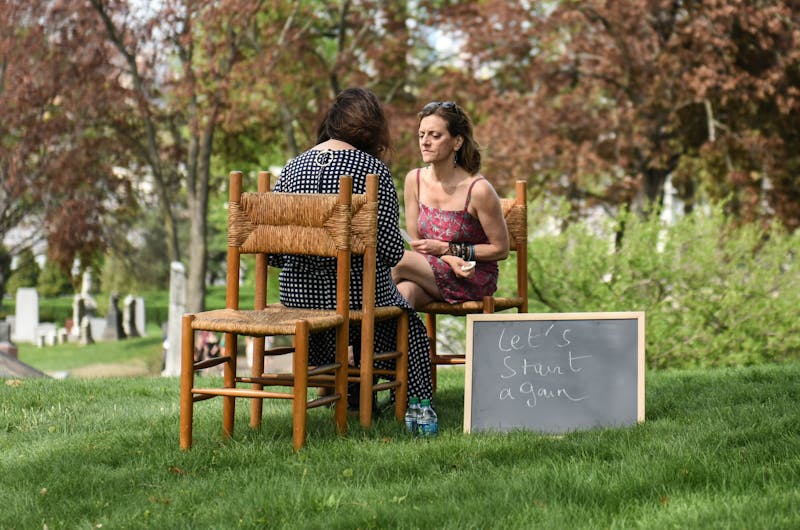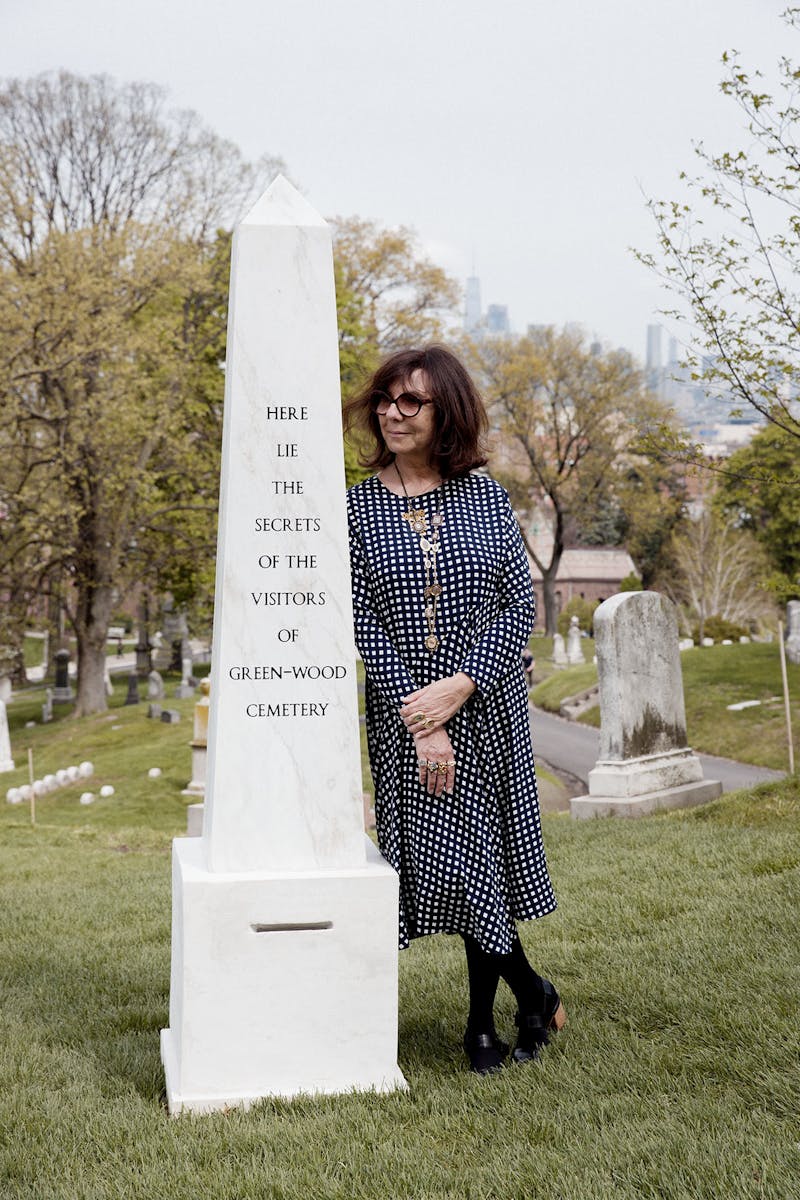Would I be able to stop sneezing for long enough to meet Sophie Calle, the world’s most important living conceptual artist? For her newest work Calle had chosen a plot in Brooklyn’s Green-Wood Cemetery. As we crept along the line to share the secrets that Calle would commit to a grave beneath our feet, the pollen of every tree planted to shade the dead seemed to enter my nose. If only I had wept from the eyes instead, my streaming face would have matched the setting—big and pompous mausoleums, tiny headstones reading only “mother”—and the work at hand.
The project is called Here Lie the Secrets of the Visitors of Green-Wood Cemetery: 2017 – 2042. You tell Sophie Calle a secret, she writes it down, then you pop it through a little slot in an obelisk and there your secret stays. I’ll be 54 when it ends. Calle herself will be 89. In a leaflet distributed to visitors, Calle explains that a “cemetery plot has been granted to me ‘in perpetuity,’ which means the project will continue for 25 years.”
We have an idiom about this: We say we will “take the secret to the grave.” The French have the same one, emporter son secret dans la tombe (Calle is French). When Calle takes your secret to the grave, she is turning the confidence of friendship into a highly formalized artistic gesture. She stretches it out, makes it more romantic. The obelisk is more like a commemorative tribute to the very idea of sharing secrets. The secrets themselves are the medium, the act of secret-sharing the art.
The line took forever, which was good because we were queuing at the perfect spot to observe those already confessing to Calle. They were too far away to hear, but we could see their faces as they sat on Van Gogh wicker chairs. The faces mostly had small smiles on them. The wind took their words away. There had been a thunderstorm the night before and the air felt gentle and cleansed of its violence. The women mostly wore long billowing dresses, many of them red or hot coral. Several people kept their sunglasses on while telling Sophie Calle their secret.

Calle was born in Paris in 1953. Her work deals with grief, absence, unknowability, emotional wounds. In a famous early work called Suite Venitienne (1979), she followed a man from Paris to Venice. Once in Venice, she continued to follow him, dressed in a disguise. She took photographs and exhibited her surveillance. In 1983 she did something similar with Address Book. She had found an address book in the street. She called numbers in it, drew up a portrait of the book’s owner by speaking with his contacts. The man was very angry.
His anger was the perfect final touch to an artwork about intimacy (the secret phone numbers) and desire (her wish to burrow inside his life). Calle’s work is always a bit emotionally repulsive, too close to the bone, too deeply felt.
But, by the same token, it is Calle’s ongoing engagement with emotion that makes her work feel particularly relevant now. People want to access the interior lives of women artists and writers. The renaissances of Chris Kraus and Tracey Emin; the MacArthur “genius grant” for Maggie Nelson; the words “emotional labor” appearing in HuffPo: These are all evidence of our moment’s interest in the way that lived experience is particularized by gender.
Calle’s most recent cultural “hit” was the 2007 Venice Biennale piece Take Care of Yourself, in which Calle asked women to read a breakup email from a former boyfriend, curating the results into an installation. That work echoed the way that strangers use the internet collaboratively to break down, interpret, and gloss communications. (Think of a snippet of a text message shared on Twitter.) But it also touched on the professional identities of these women. Among those involved in the project were a copy-editor, a judge, and a psychiatrist. On the face of it, the work presented a community of women created out of response to a trauma. But it also pointed out the places where women’s emotional work and professional work coincide and blur together.
Secret-keeping is a specifically female kind of chore. As Calle sat and listened to my secret, her attention was active. She asked clarifying questions, which was unexpected and frightening. She listened like a friend, or perhaps some kind of high-ranking adviser whose job it is to make the speaker feel that their confidence is the most valuable thing in the world. She listened like a woman, I suppose.

At Green-Wood Cemetery, Calle wore a blue and white outfit, reminiscent of gingham in its pattern but unspeakably expensive in its movement in the breeze. Everybody looked so beautiful in the dappled sunlight, especially when big clouds of pink blossom gusted past. I thought of the women rotting under pieces of stone that read “wife” or “daughter” or similar.
There are a lot of women with my name buried in the graveyard, since it’s a bit old-fashioned. My secret was about being a female person in the world, and a little about death. I was with friends in the cemetery, but since none of us wanted to reveal our secrets to each other we had wonderfully strange conversations, referring to “my secret” and talking around the secrets themselves. Everyone agreed that it had been hard to think of one in the first place, though. We used to have so many, but not anymore.
I like to think of my secret underground there, where my body will never lie because I want it to be burned up and its ashes scattered. Does a body rot faster than a piece of paper, or just differently? If a worm eats a bit of your body, and then a bit of my paper secret, does that make us related? Will Sophie Calle even be alive when this project finishes and, if not, where is her body going to lie? These must be the secrets that only a grave knows.
